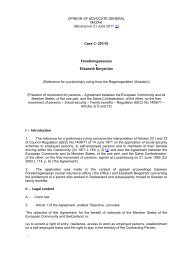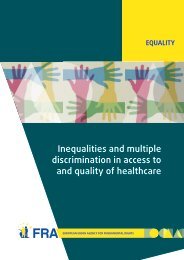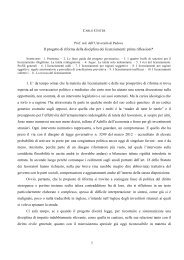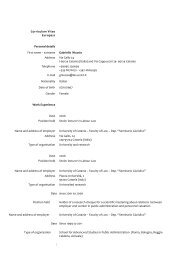Study on non-legislative initiatives for companies to promote gender ...
Study on non-legislative initiatives for companies to promote gender ...
Study on non-legislative initiatives for companies to promote gender ...
You also want an ePaper? Increase the reach of your titles
YUMPU automatically turns print PDFs into web optimized ePapers that Google loves.
Gender equality <strong>initiatives</strong> 53<br />
1 Introducti<strong>on</strong><br />
1.1 Background and Aims of the <str<strong>on</strong>g>Study</str<strong>on</strong>g><br />
The present ‘<str<strong>on</strong>g>Study</str<strong>on</strong>g> <strong>on</strong> n<strong>on</strong>-<strong>legislative</strong> <strong>initiatives</strong> <strong>for</strong> <strong>companies</strong> <strong>to</strong> <strong>promote</strong> <strong>gender</strong><br />
equality at the workplace’ has its background in the Community programme <strong>for</strong> employment<br />
and social solidarity (PROGRESS). The aim of PROGRESS 4 is <strong>to</strong> financially<br />
support the implementati<strong>on</strong> of the objectives of the European Uni<strong>on</strong> in the area of<br />
employment and social affairs.<br />
More specifically, the study has its c<strong>on</strong>text in the 2008 Annual Plan of Work 5 which is<br />
the strategic framework <strong>for</strong> the implementati<strong>on</strong> of PROGRESS. One of the priorities set<br />
out in this plan is <strong>to</strong> give attenti<strong>on</strong> <strong>to</strong> <strong>gender</strong>-related issues in the field of the European<br />
Employment Strategy, including <strong>gender</strong> equality at the workplace, and of the OMC <strong>on</strong><br />
social protecti<strong>on</strong>. PROGRESS supports the implementati<strong>on</strong> of the policy objectives <strong>for</strong><br />
the next five years in this area, as defined in the ‘Roadmap <strong>for</strong> equality between women<br />
and men, 2006-2010’ 6 .<br />
Gender equality is a fundamental right, a comm<strong>on</strong> value of the EU and a necessary<br />
c<strong>on</strong>diti<strong>on</strong> <strong>for</strong> the achievement of the EU objectives <strong>on</strong> growth, employment and social<br />
cohesi<strong>on</strong>. The combined ef<strong>for</strong>ts of the Community and the Member States genuinely<br />
helped <strong>to</strong> trans<strong>for</strong>m the situati<strong>on</strong> of men and women in Europe. This is reflected in a<br />
steadily increasing female participati<strong>on</strong> in employment and a higher level of educati<strong>on</strong><br />
as compared <strong>to</strong> men 7 . Although female employment rates have risen str<strong>on</strong>gly over<br />
recent years, women are still disadvantaged <strong>on</strong> the labour market, as labour market<br />
segregati<strong>on</strong> and inequalities in working arrangements still persist. This is also reflected<br />
in a significant and c<strong>on</strong>tinuing <strong>gender</strong> pay gap.<br />
According <strong>to</strong> the Report <strong>on</strong> equality between women and men (2009), the employment<br />
rate, although rising and now close <strong>to</strong> the Lisb<strong>on</strong> objective of 60 % is still lower <strong>for</strong><br />
women (58.3 % in the EU-27 in 2007) than <strong>for</strong> men (72.5 %), with major differences<br />
between Member States. Furthermore, in terms of sec<strong>to</strong>ral as well as occupati<strong>on</strong>al<br />
segregati<strong>on</strong>, the labour market is still compartmentalised because women still go in<strong>to</strong><br />
sec<strong>to</strong>rs and occupati<strong>on</strong>s already dominated by women. Public administrati<strong>on</strong>,<br />
educati<strong>on</strong>, health and social welfare are sec<strong>to</strong>rs dominated by women. Half of female<br />
workers have low-status and low-pay occupati<strong>on</strong>s. Thus, women’s high and increasing<br />
level of educati<strong>on</strong> is not yet reflected in their labour market positi<strong>on</strong>s.<br />
There is also an under-representati<strong>on</strong> of women in the decisi<strong>on</strong>-making process:<br />
Across the EU, in 2008, there was an average of 24 % women in all houses of the<br />
nati<strong>on</strong>al parliaments, which is still below the so-called critical mass of 30 %, deemed <strong>to</strong><br />
be the minimum necessary <strong>for</strong> women <strong>to</strong> exert meaningful influence <strong>on</strong> politics. At<br />
regi<strong>on</strong>al level, women have a str<strong>on</strong>ger political voice than at nati<strong>on</strong>al level, with<br />
reaching an average of 30 % representati<strong>on</strong> in regi<strong>on</strong>al assemblies. 8 When examining<br />
the field of business, across Europe, women account <strong>for</strong> over 44 % of all workers but<br />
4<br />
5<br />
6<br />
7<br />
8<br />
http://ec.europa.eu/employment_social/progress/index_en.html<br />
http://ec.europa.eu/employment_social/progress/docs/progress_005_en.pdf<br />
COM(2006) 92 final<br />
European Commissi<strong>on</strong> (2009): Report <strong>on</strong> equality between women and men 2009.<br />
European Commissi<strong>on</strong> (2009): Women in European politics – time <strong>for</strong> acti<strong>on</strong>
















